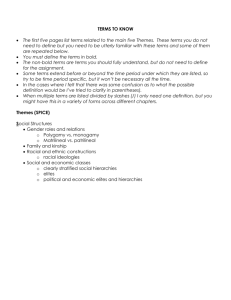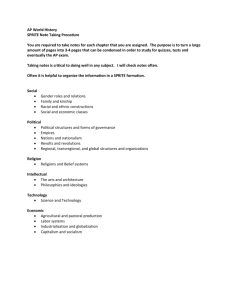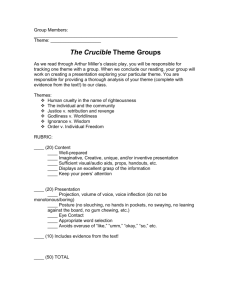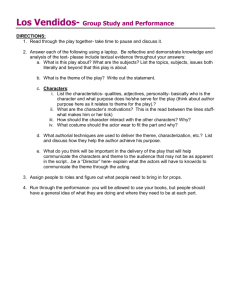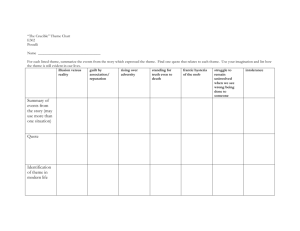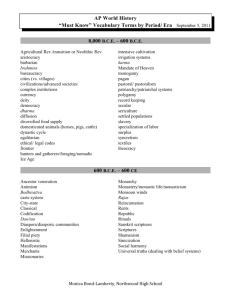AP World History “Must Know” Vocabulary Terms by Theme Theme
advertisement
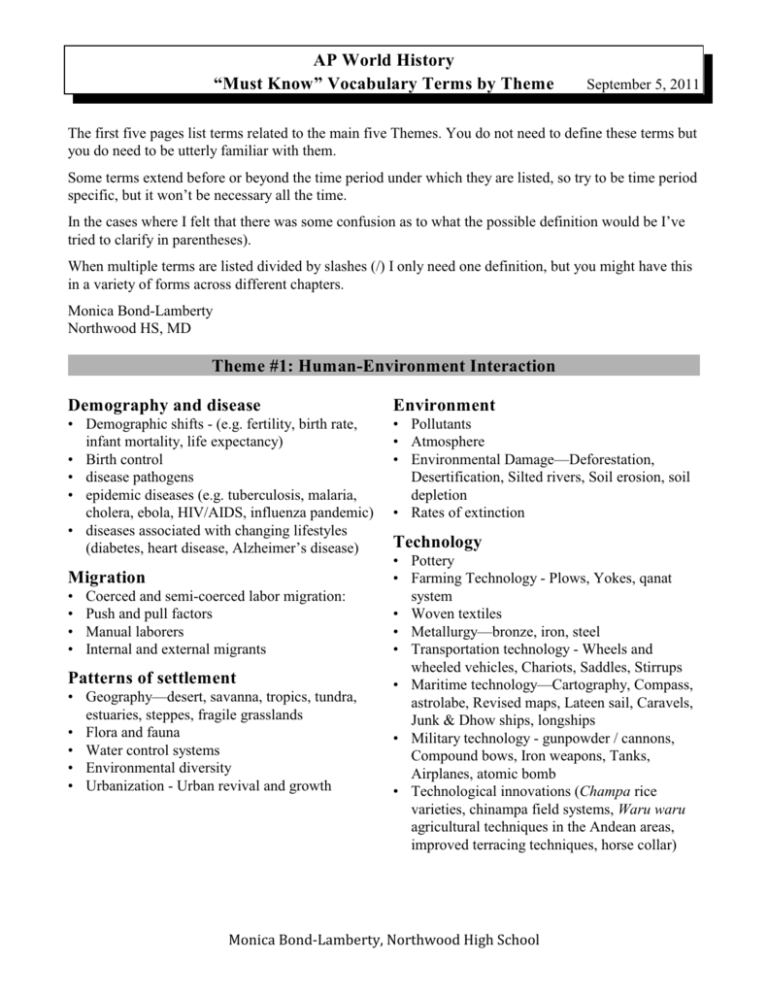
AP World History “Must Know” Vocabulary Terms by Theme September 5, 2011 The first five pages list terms related to the main five Themes. You do not need to define these terms but you do need to be utterly familiar with them. Some terms extend before or beyond the time period under which they are listed, so try to be time period specific, but it won’t be necessary all the time. In the cases where I felt that there was some confusion as to what the possible definition would be I’ve tried to clarify in parentheses). When multiple terms are listed divided by slashes (/) I only need one definition, but you might have this in a variety of forms across different chapters. Monica Bond-Lamberty Northwood HS, MD Theme #1: Human-Environment Interaction Demography and disease Environment • Demographic shifts - (e.g. fertility, birth rate, infant mortality, life expectancy) • Birth control • disease pathogens • epidemic diseases (e.g. tuberculosis, malaria, cholera, ebola, HIV/AIDS, influenza pandemic) • diseases associated with changing lifestyles (diabetes, heart disease, Alzheimer’s disease) • Pollutants • Atmosphere • Environmental Damage—Deforestation, Desertification, Silted rivers, Soil erosion, soil depletion • Rates of extinction Migration • • • • Coerced and semi-coerced labor migration: Push and pull factors Manual laborers Internal and external migrants Patterns of settlement • Geography—desert, savanna, tropics, tundra, estuaries, steppes, fragile grasslands • Flora and fauna • Water control systems • Environmental diversity • Urbanization - Urban revival and growth Technology • Pottery • Farming Technology - Plows, Yokes, qanat system • Woven textiles • Metallurgy—bronze, iron, steel • Transportation technology - Wheels and wheeled vehicles, Chariots, Saddles, Stirrups • Maritime technology—Cartography, Compass, astrolabe, Revised maps, Lateen sail, Caravels, Junk & Dhow ships, longships • Military technology - gunpowder / cannons, Compound bows, Iron weapons, Tanks, Airplanes, atomic bomb • Technological innovations (Champa rice varieties, chinampa field systems, Waru waru agricultural techniques in the Andean areas, improved terracing techniques, horse collar) Monica Bond-Lamberty, Northwood High School 2 AP World History “Must Know” Vocabulary Terms by Theme September 5, 2011 Theme #2: Culture (Development & Interaction of …) Religions The Arts and Architecture • • • • • • • • Monumental architecture and urban planning (e.g. Pyramids, Ziggurats, Temples, defensive walls, streets and road, Sewage and water systems) • Arts and artisanship (Elaborate weaving, Painting, Sculpture, Wall decorations, Courtly literature, Miniature paintings, Renaissance art, Wood-block prints) Monotheism Polytheism Buddhism Christianity Hinduism(s) / Vedic religion Islam Judaism Belief systems, philosophies, & Ideologies • • • • Confucianism & Neoconfucianism Daoism Greco-Roman philosophy revelation Science and Technology • • • • Energy technologies oil and nuclear power Reason empirical observation Cultural • • • • Languages—Turkic, Arabic Sports—Cricket Music and film - Reggae, Bollywood Literature - Book of the Dead, Rig Veda, “Epic of Gilgamesh,” Kabuki, codices • Systems of Record Keeping—Hieroglyphs, Pictographs, Quipu, Alphabets, Cuneiform Theme #3: Politics (State-building, Expansion & Conflict) Political Structures and Forms of Governance • Political /state authority and autonomy centralized control/ governments • state consolidation, legitimization and expansion of power • military professionals • political ideologies • bureaucracies/ administrative institutions • Collection of revenue • Warfare—casualties, tactics, Empires • • • • • • Trading-post empires Land empires Diplomacy Maritime empires Transoceanic empires Imperial conquests / Expansion • Indigenous homelands • Internal factors and external factors Nations and nationalism • • • • • nation-states nationalist ideologies national aspirations (imagined) national communities Nation Building/State Building Revolts and revolutions • • • • Political and social discontent Rebellions and protests Dissent and resistance movements of political reform Regional, Transregional, and Global Structures and Organizations • transregional political organization • institutions of global governance Monica Bond-Lamberty, Northwood High School AP World History “Must Know” Vocabulary Terms by Theme • New international organizations (e.g. United Nations, League of Nations, International Criminal Court) 3 September 5, 2011 • Humanitarian organizations (e.g. UNICEF, Red Cross, Amnesty International, Doctors Without Borders, World Health Organization (WHO)) Theme #4: Economic Systems (Creation, Expansion & Interaction of …) Agricultural and Pastoral Production Labor systems • • • • • Specialized professionals—merchants, artisans and warriors • Free peasant labor or Peasant communities • Craft production or guild organization • Government-imposed labor taxes • Family and household production • Coerced labor - Indentured servitude, Corvée • Unfree labor—Slavery, Convict labor, Chattel slavery • Slave systems / slave trade American Foods—Potatoes, Maize, Manioc Staple crops—wheat, rice, sorghum, Cash crops—Sugar—, Tobacco Foods brought by African slaves—Okra, Rice Trade and Commerce • Commercialization • Commercial entrepreneurs and • Luxury goods (Silk and cotton textiles, Porcelain, Spices, Slaves, Exotic animals) • Commercial entrepreneurs • Trade routes: Trans-Saharan caravan routes, Indian Ocean sea lanes, Mediterranean sea lanes, Silk Roads • Caravan organization (Caravanserai, Camel saddles) • Forms of credit and Monetization (Minting of coins, Use of paper money, Bills of exchange, Checks, Banking houses) • Transoceanic shipping services • Piracy • Global integration - World economic network / world system Industrialization • Coal, iron and timber • Steam engines / internal combustion engine / fossil fuels / coal and oil • Steel / chemicals / electricity / precision machinery / • Developments in transportation and communication (Railroads, Steamships, Telegraphs, Canals) • Increased Economic Productive Capacity Capitalism and socialism Theme #5: Social Structures (Development & Transformation of …) Gender roles and relations • racial ideologies • Polygamy vs. monogamy • Matrilineal vs. patrilineal Social and economic classes • clearly stratified social hierarchies • elites • political and economic elites and hierarchies Family and kinship Racial and ethnic constructions Monica Bond-Lamberty, Northwood High School
